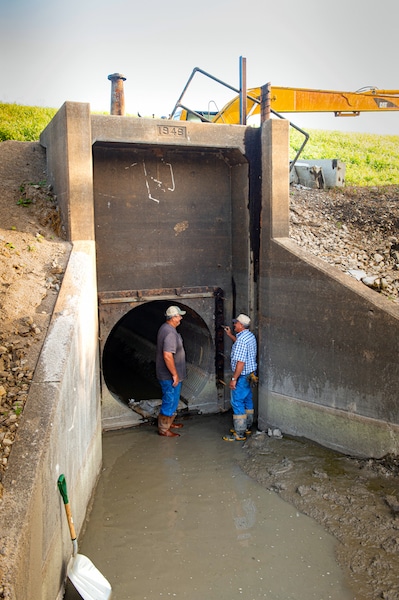Aging levee near Fults needs repairs

A lot of water can flow through a drain pipe that’s six feet in diameter.
The pipe in question is a critical part of the Stringtown Drainage & Levee District levee that protects about 2,500 acres of high value farmland and structures.
The issue was brought up during the Monroe County Board meeting on Sept. 8 when Lynden Prange, who was reappointed as levee district commissioner, laid out the problem for the board. Prange said the gravity drain was inoperable and he hoped they would be able to repair it since the Mississippi River has dropped below 10 feet on the St. Louis gage – leaving the drain completely out of the water for the first time in months.
Prange and fellow levee district commissioner Butch Sensel said the large pipe that leads under the levee and its opening and closing gate mechanism were installed in 1948.
The drain’s purpose is to allow water that has either seeped under the levee during floods, or which fell as rain inland and flowed toward the river, to be drained back into the river after flooding ended and the river fell. It must be closed fully before the river rises above 22 feet – toward an official flood designation of 30 feet – to prevent a back flow into the protected property.
But the current gate repair work requires a level of 10 feet or less.
The first problem with closing and opening the gate emerged from wear to the hand-cranked gear mechanism that raises and lowers the one-piece steel gate that seals the pipe. Parts had to be replaced. The levee district was able to secure required parts from a Massachusetts firm for $15,000.
But the gate itself remained immovable and it was discovered the steel frame structure that allowed it to be raised and lowered was no longer working properly. To repair it required rails guiding the gate had to be removed and 18 larger-than-thumb-sized bolts more than a foot long each had to be removed and replaced.
Prange and Sensel said that when contractors for the U.S. Army Corps of Engineers installed the gate, it was supposed to be maintained by the Corps. But, as Prange told the county board, in the 1970s the law changed and it fell back on local levee districts to maintain.
Monday morning, Red Bud welding and fabrication firm Guebert’s Custom Repair began work to remove and replace the age-damaged bolts to enable reinstallation and operation of the gate – all hopefully before any raises in the river’s elevation.
U.S. Army Corps of Engineers St. Louis District Chief of Emergency Management head John Osterhage confirmed the Corps has neither authorized nor appropriated funding to carry out this repair for local districts. He said personnel from the district had visited and consulted with levee commissioners but were unable to help with other than advice.
Absent Congress giving specific authority and funding, nothing more can be done, he said.
Prange said this was true when there was no emergency.
“But if the river was to flood and reach an elevation of 30 feet, they could bring emergency money to bear, driving sheet piling in to cut the flow and then after the flood subsided, replace the structure,” he said.
Prange said a rough estimate for such work would be $1.2 million.
“And there are some 18 of these six-foot pipes between the Jefferson Barracks Bridge and Chester, all installed between 1947 and 1951. They are supplemented by another 12 24-inch diameter drains. We are just the unfortunate people to have ours fail first,” he said.
Any of these failing examples could be catastrophic for the property they protect when they work properly.
“I don’t blame the Corps. I just wish Washington and Congress would look at this in a different perspective,” Prange said.
Is there a Plan B if the river valley upstream sustains unexpected heavy rain and rises swiftly?
“We tried using railroad ties to close the opening, but they were not a good answer. So, we had concrete stop logs built and they are better at reducing the flow – but not perfect,” Prange said.
Some early estimates to repair this structure ran from $200,000 to $400,000.
“We have an annual budget of $10,000, derived from owners of acreage the levee – and this pipe – protects,” Prange said. “That supports regular maintenance such as gasoline for mowing and other minor work. But what bank would loan us that kind of money on a 30-year loan – especially since we have no collateral to put up? The land under the levee is owned by the farmers.”
Prange reported good progress Monday afternoon.
“Drilling out the bolts proved to be time consuming and hard on drill bits. So, business owner Eric Guebert decided to try an air arc – a welder that includes an air stream that helps remove material,” Prange said.
They hoped to have the bolts all removed on Tuesday.
“Then it will be replacing the bolts and reinstalling the gate, making adjustments and hopefully successfully raising and lowering it to ensure it is repaired,” he said, adding the hope is to finish this work within the week. “Other levee districts are watching to see how our plan works.”.
That still leaves nearly two-and-a-half dozen aging drain pipes, gates and their mechanisms to be repaired as they possibly give out up and down the river.
And time is passing.






